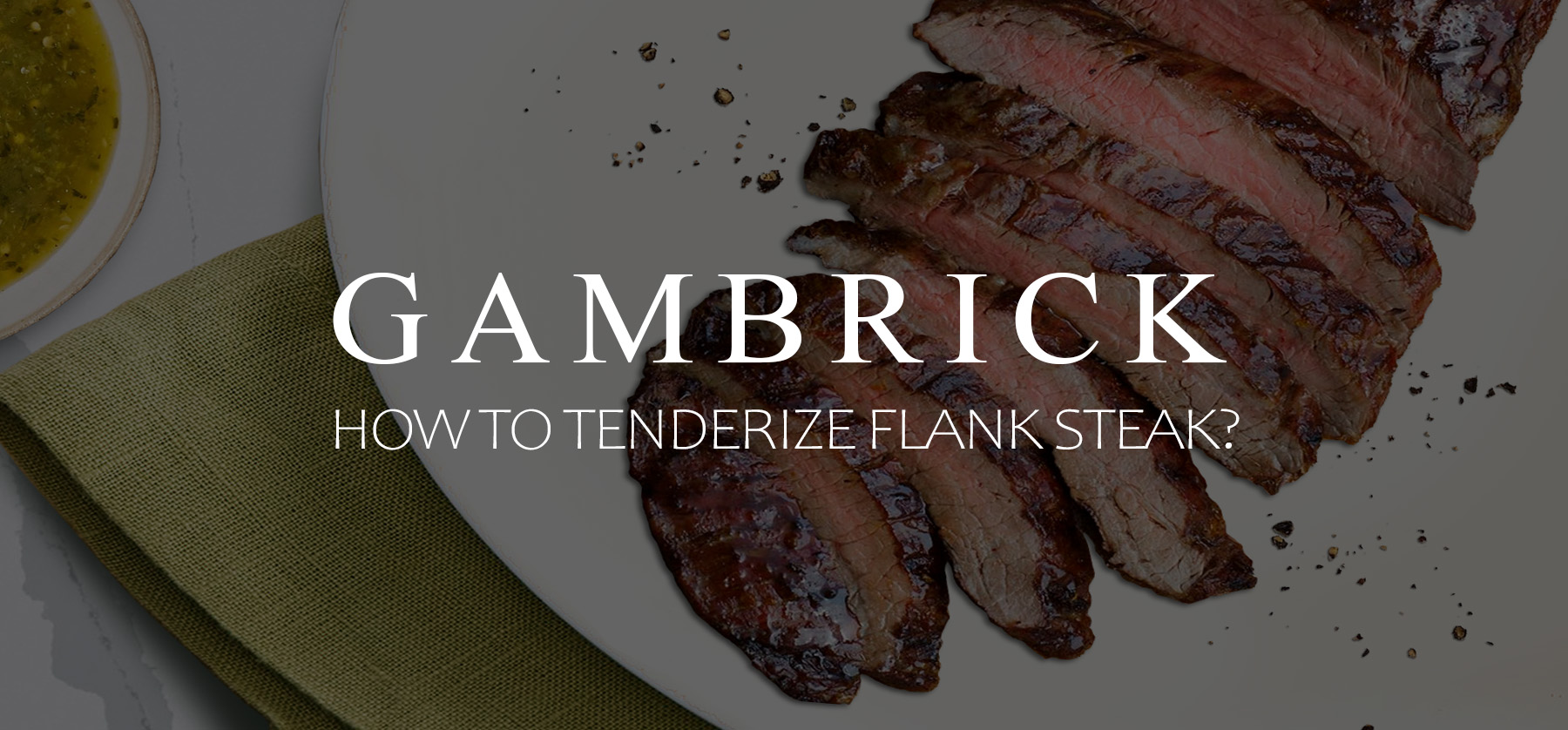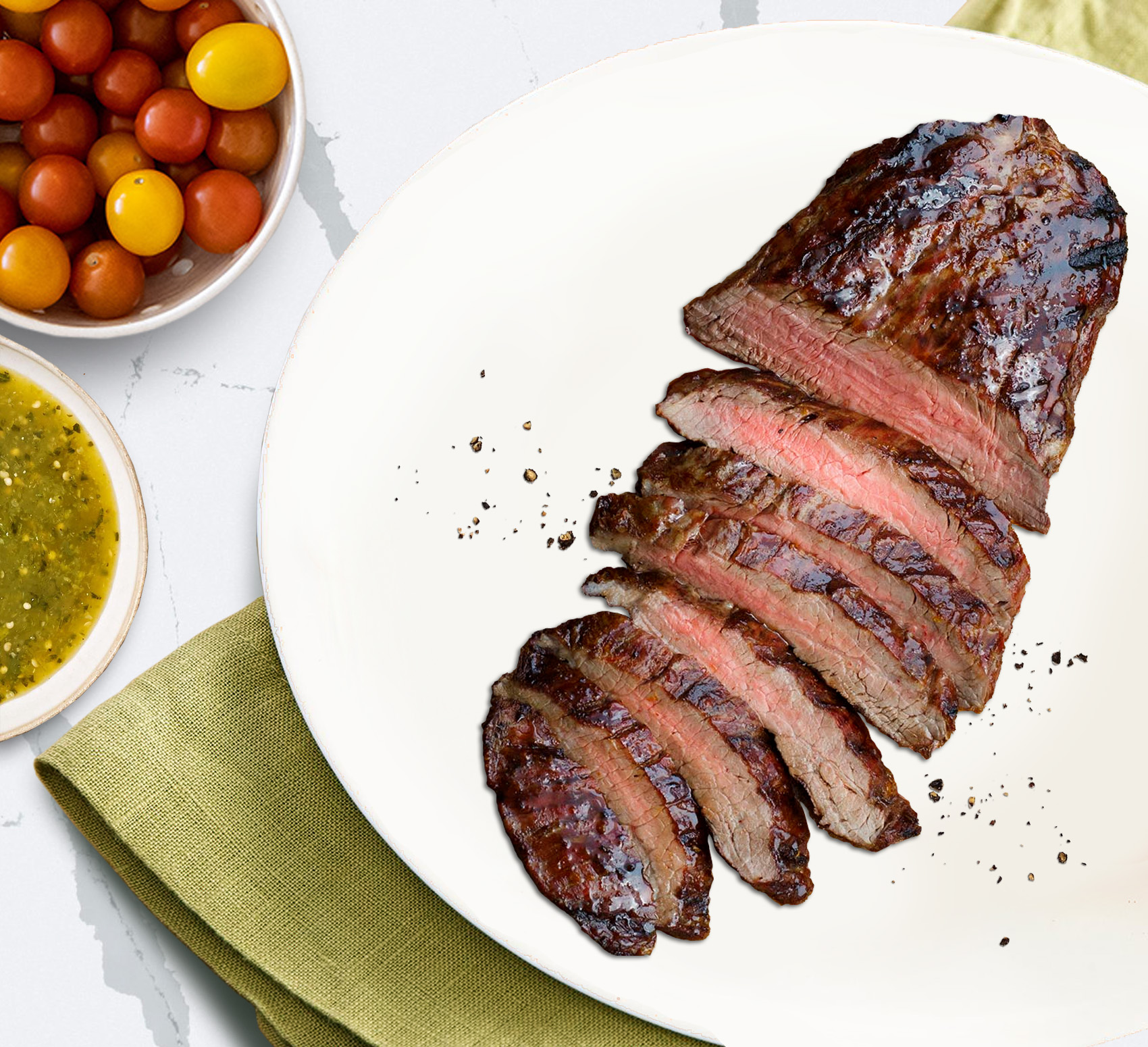How To Tenderize Flank Steak
Flank steak is cut from the cow’s lower abdominal muscle just below the tenderloin. It’s an inexpensive & flavorful piece of beef that’s used in a variety of steak dishes like tacos, fajitas and stews. But it’s very lean meat with almost no marbling, which makes it a bit tough. However when Flank is tenderized and soaked in a marinade, the meat can be tender and juicy. Flank Steaks are usually around an inch or so thick, about a foot long and 5 to 6 inches wide. The best way to tenderize a Flank Steak is by pounding it with a spiked mallet until dimples appear followed by an acid based marinade. Both methods break down tough muscle fibers and connective tissue which tenderizes the meat.
Tenderizing a Flank Steak makes it easier to chew and maximizes the meat’s flavor.
Flank Steak is naturally a tough cut of beef that can be a bit chewy. But it varies based on the age of the cow, how they were raised and what they were fed. To make tenderizing easier, start with the freshest, best quality Flank Steak you can find.
There are several techniques you can use to tenderize a Flank Steak including pounding both sides with a spiked mallet, marinades, enzymes, baking soda and salt. But the best way to do it is using a spiked mallet followed by a marinade. A mallet and marinade tenderize meat in different ways so using them together creates a more tender, juicy and flavorful steak.
Finally, when you’re ready to slice your Flank Steak, make sure to do it against the grain. This makes the meat easier to chew.
In this article we’ll discuss the different step-by-step ways you can tenderize a Flank Steak along with some helpful tips and information.
What Makes Flank Steak Tough & Chewy?
Steaks are actually muscles cut from a cow.
Muscles that get lots of exercise are denser with less fat marbling. This makes them tougher and harder to chew. But areas of a cow that don’t get used as much are softer with more marbling. This makes the meat more tender and flavorful.
- Muscles at the top of the animal, around the backbone and ribs, don’t get much exercise so the meat is soft and tender with more marbling. These are your high-end cuts like prime rib, tenderloin, porterhouse, etc. Unfortunately these areas tend to be smaller which is why an entire cow only provides a few prime steaks. This increases the price of the meat.
- Working parts of a cow, like the legs, neck and lower muscles, get more exercise so the meat is tough and sinewy with more strips of fat and less marbling. There are more tough cuts on a cow than tender cuts so the price is much lower. These include Chuck, Brisket, Skirt, and Flank.
Muscle is made up of long strings of connective tissue called fibers. Surrounding the muscle fibers are a thin gelatinous substance called collagen and fat.
Tenderizing beef before you cook it breaks down and weakens these fibers which makes the meat softer and more tender.
The primary ways Flank Steak is tenderized is by pounding it with a spiked mallet. The mallet breaks down tough muscle fibers and connective tissue while creating small dimples along the meats surface.
You can also use a marinade to further tenderize a Flank Steak. The dimples created by a spiked mallet allow the marinade to penetrate deeper into the meat.
Pounding a Flank Steak and a marinade both tenderize meat, but they do it in different ways. This is why using both methods together is so effective.
The Best Way To Tenderize A Flank Steak
Flank Steak is a tough and lean cut of beef. Try to select the freshest cut of steak you can get with some amount of fat or marbling. Even among tough cuts of beef, some steaks are more tender than others.
Fat imparts flavor to the meat which can become dry after grilling or cooking at high temperatures. However, too much fat isn’t good for your health, and doesn’t add anything to the dish. Look for steak with some marbling rather than large chunks of fat on the sides.
Tenderizing a Flank Steak is done by beating it with a spiked meat tenderizer on both sides. Once the pounding is done you can tenderize it even more with a marinade. Pounding the meat softens tough muscle fibers and connective tissue while creating small dimples. These dimples allow marinade to penetrate deeper into the beef.
- Lightly wrap the meat in waxed paper or plastic and place it on a cutting board.
- Using a spiked meat mallet, hit the Flank Steak hard enough to leave dimples in the meat.
- Pound both sides of the meat evenly.
- Remove meat from the wrap and place it into your marinade.
Once you tenderize the Flank Steak with your mallet, marinate it overnight in the refrigerator with an acid based marinade.
The best way to make a Flank Steak tender is by softening it with a meat mallet and then marinating it.
Which marinade you use is a personal preference, but I recommend using one with some acid or fruits. Try lemon, orange, wine, vinegar or other citrus fruits. Acids and enzymes found in many fruits naturally break down and soften tough muscle fibers and tissue.
Marinating time matters. I like to marinade my Flank Steaks for at least 8 hours.
Tenderize Flank Steak With A Mallet
Flank steaks are thin, fairly lean and a bit tough. But they have tons of flavor are great in beef dishes like stir fry, fajitas, tacos or a stew. But they’re rarely eaten as a traditional steak.
Flank Steak is naturally a tough cut of beef. But the age of the cow, how they were raised and what they were fed helps determine how tough a Flank Steak is. Try to use the freshest, best quality meat you can find because it will be more tender.
Flank is cut from the cow’s lower abdominal muscle just below the tenderloin. This area gets a lot of exercise as the cow walks around and stands, which makes the meat tougher. This is why Flank Steak benefits so much from tenderizing before you cook it.
The best way to tenderize a Flank Steak is by pounding it with a spiked mallet.
Repeatedly pound the steak on both sides. This not only tenderizes the beef but also creates small dimples which allows rubs, spices, sauces and marinades to penetrate deeper into the meat.
- Wrap the beef in waxed paper or a plastic bag. This will contain the meats juices as you hit it.
- Repeatedly pound the steak hard on both sides. This not only tenderizes the meat but also creates small dimples in the beef.
- The blunt force of a mallet helps break the bonds which hold muscle fibers together.
- Pounding the meat enhances the tenderizing effects of a marinade by opening up the beef’s muscle fibers.
As you pound the steak, tough muscle fibers are broken down and torn apart. This makes a Flank Steak softer, more tender and easier to chew.
How To Tenderize Flank Steak With A Mallet
Tenderizing Flank Steak with a meat mallet is easy to do. Here are some helpful tips if you’ve never done it before.
- Wrap the beef in some wax paper or plastic wrap to avoid cross contamination of surfaces. You can tenderize meat without wrapping it, but make sure you clean up thoroughly afterwards.
- Use a good quality dish-washer-safe cutting board that’s well sanitized.
- Meat mallets come flat and spiked. The spiked end works better for tenderizing steak. The flat side is better if you want to flatten the meat a little.
- Hit the beef hard with the mallet but not too hard. You don’t want to damage the meat. Hit it hard enough to form dimples but not hard enough to shrink the meat.
- As you hit the beef you’ll notice dimples on the surface from the mallet spikes. This means you’re breaking down and penetrating into the muscle fibers. When you’re all done, turn the steak over and do the same on the other side.
- If you hit the steak too hard it’ll start to get slimmer. You don’t want this to happen because the meat can get tougher when it’s compressed. Just hit it hard enough to form some deep dimples and break up the muscle fibers a bit.
- Once both sides are pounded you’re all done.
- Remove the steak from the wax paper or plastic wrap and place it in a marinade.
Tenderize Flank Steak With A Marinade
A great way to tenderize Flank Steak is with an acidic marinade.
Not just any marinade will tenderize a steak, it has to contain some acid like lemon, lime or kiwi. Fruit is actually a really good tenderizer because many contain acids.
Acids break down proteins and tough connective tissue which tenderizes the steak. Lemon juice, wine, vinegar, beer and soda are all strong tenderizers. Even liquids like buttermilk and yogurt will help tenderize meat because of their acidic qualities.
Combine a tenderizing marinade with a meat mallet for an even more tender steak. Pounding the meat with the spiked edge of a mallet creates dimples which allow the marinade to penetrate deeper into the steak.
Marinade only tenderizes the surface of the meat it touches. So if you don’t pound the beef first you’ll only tenderize the outer edges. But because Flank is so thin, this is sometimes enough to soften the entire steak. But Flank is tough so I recommend both a pounding and a marinade.
Here’s how you do it:
- Place your steak in a food-safe container and add your favorite marinade over it. This works better if you pound the meat with a spiked mallet first.
- Both sides of the steak should be bathed in marinade.
- Place the steak in the refrigerator.
- Let the steak rest for at least 30 minutes and no more than 24 hours. I recommend marinating for 8 hours.
- Remove the steak and start cooking.
Use a clean paper towel to blot the steak dry before cooking or grill it while still wet.
Pro Tip: When marinating with acids, use a non-reactive container like glass or Ziploc bags. A metal bowl can react with the acids giving your steak a strange metallic flavor.
How Long Should I Marinade Flank Steak?
The ideal time to marinate a Flank Steak is 8 hours in the fridge. Turn the meat over every 2 to 4 hours to keep it drenched in marinade. But you can marinade steak for up to 24 hours. Don’t go over 24 hours or it can become mushy.
If your short on time, marinating beef for just 2 to 3 hours in the refrigerator will make a big difference.
When you’re done marinading, remove the steak and broil it. You can either pat dry the meat with a paper towel or cook it wet. I prefer cooking a Flank Steak while the marinade is still on and will often drizzle the meat with some marinade as it cooks.
Tenderizing a Flank Steak with both a spiked meat mallet and a marinade will make it as tender as it can be.
You can cook a Flank Steak either by grilling or broiling. Both methods produce a great tasting and tender steak.
Cook the meat until it’s medium to medium rare and don’t overcook it.
Cut the meat across the grain and never along the grain. This makes the meat easier to chew. Make thin slices and serve with a savory sauce and baked potatoes or vegetable on the side.
Tenderize Flank Steak With Salt
Coating a Flank Steak with salt is another good way to tenderize it.
Don’t use regular table salt to tenderize a steak. It contains iodine which can give the meat a strange chemical flavor. It’s also too fine which makes it hard to wash off later. Table salt usually results in a weird tasting over salted steak. Use coarse kosher or sea salt instead.
You can use salt along with a pounding to tenderize a steak. The dimples created when you pound the meat allow the salt to penetrate deeper into the steak.
Tenderizing a Flank Steak with salt is easy, here’s how:
- Sprinkle coarse salt generously over both sides of the steak.
- Allow the steak to rest for at least an hour.
- Rinse off the excess salt.
- Dry the steak with a clean paper towel.
- Season the meat.
- Cook.
Salt draws out the steak’s natural juices which then dissolve the salt creating a brine solution. The brine then absorbs into the meat, adding in moisture while tenderizing.
In addition to tenderizing the meat, salting also gives it great flavor. Just remember not to add too much additional salt when you grill the meat. It’s easy to over salt a steak that’s already been tenderized in salt.
When you tenderize a Flank Steak with salt it will turn a little brown in color. Don’t be worried, this is normal and harmless.
Tenderize Flank Steak With An Enzyme Tenderizer
Natural enzymes are another good way to tenderize a Fkirt Steak while also adding some additional flavor.
You can buy powdered meat tenderizer at the grocery store. Meat tenderizer contains a naturally derived enzyme powder. The enzyme most commonly used is papain, which comes from papayas or bromelain, which comes from pineapples. Sprinkle the steak with tenderizer and allow the enzymes to break down those tough meat fibers.
Meat tenderizing powder works fast. Usually the meat just has to sit with the powder on for a minute or two before cooking. The enzymes do most of the work while being cooked.
Use less salt on your steak if your enzyme-based tenderizer comes with salt in it.
If you prefer using fresh fruits instead of a powder, use a marinade of kiwis, pineapple, papaya and mango instead. These fruits are good sources of tenderizing enzymes and more natural than a powder.
The enzymes found in certain fruits do an excellent job of breaking down tough muscle fibers and connective tissue. They’ll tenderize the meat making it softer and less chewy.
Even though enzymes are effective, they only work on the meat’s surface. To make them more effective, pound the beef first with a spiked mallet. The dimples created by the mallet allow the enzymes to penetrate deeper into the meat.
When enzyme tenderizers are used too long the steak can get mushy on the outside.
- If you use the powder let it sit for just a minute or two before cooking.
- If you use the fruits let the steak marinade for about an hour.
Pro Tip: When marinating with enzymes, always use a non-reactive container like glass or Ziploc bags. A metal bowl can react with the enzymes giving your steak a strange metallic flavor.
Tenderize Flank Steak On The Grill
Slow-cooked meat is tenderized by hours of cooking at low temperatures. It can be achieved with dry heat on the grill or in the smoker. Or you can use wet heat where the meat is braised in liquid for several hours. Both methods produce a more tender Flank Steak.
When you slow cook steak, the collagen surrounding tough muscle fibers melts which breaks apart and loosens the muscle.
Slow cook a steak long enough and the meat will literally fall apart.
Heat and time are essential when slow cooking. But get the temperature wrong and the beef can actually get tougher and more dried out.
Below we’ll go over how to slow cook tenderize a Flank Steak in both dry and wet heat.
Dry Heat
Season your meat, and if you used a marinade, pat it dry with paper towels. Make sure the steak is dry before placing it on the grill.
Get the grill or smoker to around 225-250 °F before you place steaks on the grill. Once the steaks are in place let them sit and slowly cook. Slow cooking a steak is a great way to make the meat tender. The slower and longer you cook it, the softer it generally becomes. In some cases a skirt can become so tender you can cut it with a fork.
Use a meat thermometer to check for an internal temperature of around 160 °F or higher. At this temperature the meat becomes moist and tender.
Cooking to a lower temperature than 160 °F, makes the collagen shrink and tighten which results in a dry and tough steak.
Once the internal temperature has reached 160°, check out the steak’s appearance and color. If the outside isn’t crisp and caramelized do a quick reverse sear on it.
Take the meat out to rest for a few minutes, then turn up the grill to 500+ °F and put the steak back on for a few minutes each side to sear the edges.
Wet Heat
Slow cooking a Flank Steak with wet heat can produce meat so tender it falls apart. It also creates some great tasting beef because you can create flavors not possible with dry heat. Try slow cooking your steaks with wine, spices, herbs and vegetables for even more flavor.
The key to this type of cooking is low heat for a long period of time.
Start by browning the meat on all sides over high heat in your Dutch oven or a cast iron skillet. This achieves a rich flavorful surface like the sear on a grill.
Remove the meat and deglaze the pan with liquid. Try wine, beer, broth or water. Add in your seasonings, veggies, onions, spices, potatoes, etc. Then put in the beef and cook with the lid on tight at around 300 °F for about 2.5 – 3 hours.
Make sure the lid stays on tight. If it’s open steam can release which dries out the meat.
Slow cooking in the oven generally works best, but a stovetop can also work as long as you keep the heat low and steady.
How To Quickly Tenderize A Flank Steak With Baking Soda
One of the fastest ways to tenderize a Flank Steak is with a Baking Soda bath. Baking soda mixed with water creates a solution that can tenderize Flank in only 15 minutes. Baking soda causes the steak’s pH level to increase while neutralizing acid found in the meat.
As pH levels rise toward the outside of the meat, proteins on the inside loosen their bonds. This results in a more tender and juicy steak.
Once you’re done tenderizing the meat, thoroughly rinse it off before adding spices and cooking. You don’t want to cook the meat if it still has baking soda on it.
Even though a Baking Soda bath can quickly tenderize a tough steak, it doesn’t do much for its taste. Add all your spices, herbs, rubs and sauces after the meat is removed from the baking soda and rinsed.
To add even more flavor, let the meat rest in a traditional marinade for 30 minute to an hour before cooking it. This will add more flavor and juices to the beef.
Here’s how to create a baking soda bath for your Flank Steak:
- Dissolve 1 tablespoon of baking soda in a ½ cup of water for every 12 ounces of steak.
- Place your meat in the solution and soak it for 15 minutes.
- Rinse with water and pat dry.
- Season the meat and cook as desired.
Remember, a baking soda bath is a fast and easy way to tenderize a Flank Steak. But it doesn’t add flavor like a traditional marinade does. So you have to spice the meat after its been removed from the bath and rinsed.
Tenderize A Flank Steak By Slicing It Against The Grain
Another way to improve the tenderness of a Flank Steak is done after you cook it. Once it’s off the grill and on the plate, cut it against the grain into thin slices. Thin slicing helps shorten tough muscle fibers which makes the meat a little softer and easier to chew.
Always cut steak against the grain. This makes the meat more tender and easier to chew.
Here are a few more tips that can help tenderize a steak:
- If your steak was marinading in a refrigerator or freezing in a freezer, bring it to room temperature before grilling. This ensures faster and more even cooking.
- Rest your steak for at least 5 minutes before serving. The steak continues to cook while it rests which consolidates its juices.
Letting a steak rest and slicing it against the grain are the final things you can do to tenderize it before serving.
How Do You Make Flank Steak Tender?
It’s a quick and easy process to make Flank Steak more tender. The best way to do it is by pounding both sides of the meat with a spiked mallet. This will created small dimples in the meat which break apart and soften tough muscle fibers.
The dimples also allow marinade to penetrate deeper into the beef if you use one.
Here are the steps you need to follow to make Flank Steak more tender:
- Pound both sides of the Flank Steak with a mallet to tenderize it.
- Marinading the steak in an acid based marinade isn’t required but it’s beneficial.
- Cook the meat quickly over high heat in a pan, pot or on the grill.
- Let it rest tented with foil for 3 – 5 minutes before slicing to retain its juices.
- Slice the meat against the grain into thin strips (about ¼ -inch thick).
Are You Supposed To Tenderize A Flank Steak?
Flank steak should be tenderized with a spiked tenderizing mallet before cooking. You can cook Flank without tenderizing it first, but it will be tough and chewy. Pound the steak on both sides hard enough to create dimples in the meat. These dimples will break up tough muscle fibers which makes the beef softer. It also allows marinade to penetrate deeper into the steak if you use one.
Some Flank Steak is sold pre-tenderized. I prefer to tenderize skirt steak myself instead of buying them pre-tenderized. And even if I buy a pre-tenderized cut, I still pound it a bit with my mallet before cooking.
I recommend using a marinade on Flank along with a meat tenderizing mallet because Flank is a very lean and tough steak that’s benefits from added fats and moisture.
How Do You Cook Flank Steak So It Isn’t Tough?
Flank Steak is thin, lean and tough meat, so it needs some tenderizing before you cook it. Pound both sides with a spiked mallet to soften up those tough muscle fibers.
Because Flank is so lean, it benefits greatly from marinades. Soak it in an acid based marinade with some olive oil to tenderize the meat while adding moisture and fat.
Slow cooking with wet heat is the best way to cook Flank Steak so it isn’t tough.
- Start by browning the meat on all sides over high heat in your Dutch oven or a cast iron skillet. This achieves a rich flavorful surface like the sear on a grill.
- Remove the meat and deglaze the pan with liquid. Try wine, beer, broth or water.
- Add in your seasonings, veggies, onions, spices, potatoes, etc.
- Then put in the beef and cook with the lid on tight at around 300 °F for about 2.5 – 3 hours.
When Flank is slow cooked on low wet heat it becomes so tender you can cut it with a fork.
If you plan on grilling Flank or cooking it in a pan, don’t go past medium-rare or medium doneness or the meat will be dry and chewy. Cook Flank fast on extremely high heat. This will sear the outside while preserving what little juices it has inside.
I always add fats to Flank when cooking it in a pan. Throw in some butter or olive oil. Flank doesn’t have much of it’s own so you need to add some yourself.
Finally, a way to cook Flank Steak so it isn’t tough is by slicing it against the grain. This makes the meat easier to chew.
How To Tenderize Flank Steak Fast
The fastest way to tenderize Flank Steak is with a spiked mallet. Pound both sides of the meat until dimples appear. This can be done in as little as a minute. Pounding a Flank Steak with a spiked meat tenderizer break up tough connective tissue and muscle fibers which softens the beef.
Next, rub some meat tenderizer on the meat. Meat tenderizers contain enzymes which soften the meat while it cooks. They’re faster than a marinade but produce a similar effect. This can be done in as little as a few minutes.
A pounding combined with a meat tenderizer can tenderize a skirt steak in as little as 2 – 3 minutes.
Summary: How To Tenderize A Flank Steak
Flank steak is cut from the cow’s lower abdominal muscle just below the tenderloin. It’s an inexpensive & flavorful piece of beef that’s used in a variety of steak dishes like tacos, fajitas and stews. But it’s very lean meat with almost no marbling, which makes it a bit tough. However when Flank is tenderized and soaked in a marinade, the meat can be tender and juicy. Flank Steaks are usually around an inch or so thick, about a foot long and 5 to 6 inches wide. The best way to tenderize a Flank Steak is by pounding it with a spiked mallet until dimples appear followed by an acid based marinade. Both methods break down tough muscle fibers and connective tissue which tenderizes the meat.
Tenderizing a Flank Steak makes it easier to chew and maximizes the meat’s flavor.
Flank Steak is naturally a tough cut of beef that can be a bit chewy. But it varies based on the age of the cow, how they were raised and what they were fed. To make tenderizing easier, start with the freshest, best quality Flank Steak you can find.
There are several techniques you can use to tenderize a Flank Steak including pounding both sides with a spiked mallet, marinades, enzymes, baking soda and salt. But the best way to do it is using a spiked mallet followed by a marinade. A mallet and marinade tenderize meat in different ways so using them together creates a more tender, juicy and flavorful steak.
Finally, when you’re ready to slice your Flank Steak, make sure to do it against the grain. This makes the meat easier to chew.
If you have any questions about tenderizing steak, email any time.






















